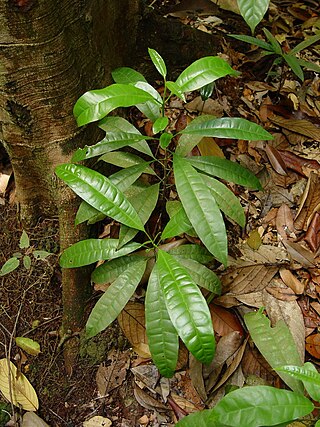
Engelhardia roxburghiana is a tree in the family Juglandaceae. It is named for the Scottish botanist William Roxburgh.

Maclurodendron porteri is a tree in the family Rutaceae.
Buchanania insignis is a tree of Borneo in the cashew and sumac family Anacardiaceae. The specific epithet insignis is from the Latin meaning 'remarkable'.
Campnosperma squamatum is a tree in the cashew and sumac family Anacardiaceae. The specific epithet squamatum means 'scaly', referring to the leaf surface.
Gluta laxiflora is a tree of Borneo in the cashew and sumac family Anacardiaceae. The specific epithet laxiflora is from the Latin meaning 'loose flowers', referring to the arrangement of the flowers.
Gluta rugulosa is a tree of Borneo in the cashew and sumac family Anacardiaceae. The specific epithet rugulosa is from the Latin meaning 'wrinkled', referring to the fruits.
Gluta sabahana is a tree of Borneo in the cashew and sumac family Anacardiaceae. The specific epithet sabahana is from the Latin meaning "of Sabah".
Castanopsis buruana is a tree in the family Fagaceae. The specific epithet buruana is from the Latin, meaning "of Buru".
Castanopsis costata is a tree in the family Fagaceae. The specific epithet costata is from the Latin meaning 'ribbed', referring to the leaf venation.
Castanopsis densinervia is a tree in the family Fagaceae. The specific epithet densinervia is from the Latin meaning 'dense nerves', referring to the leaf venation.
Castanopsis evansii is a tree in the family Fagaceae. It is named for J. H. Evans, a governor of Puerto Princesa in the Philippines.
Castanopsis foxworthyi is a tree in the family Fagaceae. It is named for the botanist Frederick William Foxworthy.
Castanopsis fulva is a tree in the beech family Fagaceae. The specific epithet fulva is from the Latin meaning 'tawny', referring to the indumentum.
Castanopsis hypophoenicea is a tree in the family Fagaceae. The specific epithet hypophoenicea means 'crimson beneath', referring to the indumentum on the leaf underside.

Castanopsis javanica, the Javan chestnut-oak, is a tree in the beech family Fagaceae. The specific epithet javanica is from the Latin, meaning "of Java".
Castanopsis lucida is a tree in the family Fagaceae. The specific epithet lucida is from the Latin meaning 'shining', referring to the leaf surface.
Castanopsis megacarpa is a tree in the family Fagaceae. The specific epithet megacarpa is from the Greek meaning 'large fruit'.
Castanopsis motleyana is a tree in the family Fagaceae. It is named for the botanist James Motley.
Castanopsis psilophylla is a tree in the family Fagaceae. The specific epithet psilophylla means 'smooth leaves'.
Lithocarpus coopertus is a tree in the family Fagaceae. The specific epithet coopertus means 'covered over', referring to the acorn.



